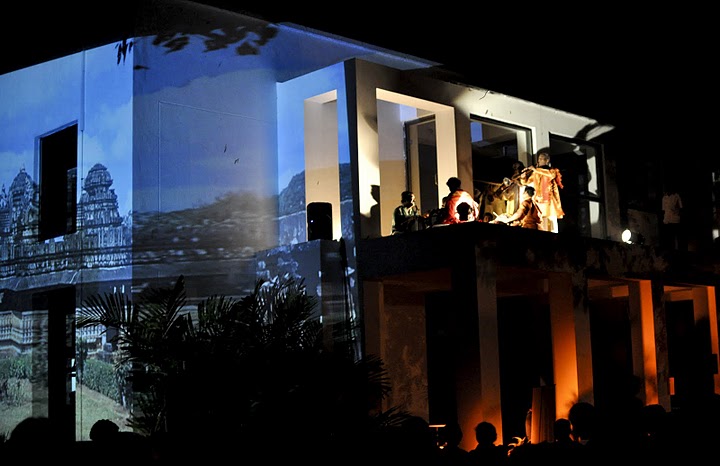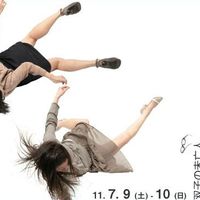Towards Creating a Vibrant Contemporary Dance Platform in India
 [caption id="attachment_14665" align="aligncenter" width="576" caption="Inaugural-a site specific performance- Attakkalari Centre for Movement Arts-India"]
[caption id="attachment_14665" align="aligncenter" width="576" caption="Inaugural-a site specific performance- Attakkalari Centre for Movement Arts-India"]Attakkalari is India’s premiere organization working in the field of contemporary movement arts. Recognized internationally as an important educational institution and cultural organization in the South Asia region, it was constituted in 1992 to facilitate the development of contemporary cultural expressions in India, particularly in the performing arts. Through its many distinct programmes it works towards creating a context for contemporary movement. These include — education and outreach, national and international platforms for exchange and performance, a diploma in movement arts and mixed media, national resource centre for stage technologies, research and documentation, the Attakkalari repertory and the Attakkalari India Biennial.
Attakkalari India Biennial:
The Attakkalari India Biennial, an international contemporary dance festival, is held in Bangalore, India, every two years since 2000. It serves as a platform in South Asia for artists to present their work, increase their visibility and broaden their base through partnerships at all levels. Apart from main stage performances, installations and site-specific work, the festival also hosts several ancillary programmes each year. In 2011, they included a week-long choreography laboratory for young choreographers; dance on camera --a section on films dedicated to dance; a 3 day seminar on ‘body, performance and writing’ and an intensive programme for South Asian journalists on dance appreciation.
The 10 day Festival brings together 150-200 artists each year. Over the last 6 editions the biennial is proud to have hosted dance company’s such as Dance Theatre CcadoO (South Korea), Nicole Seiler and Cie Phillipe Saire (Switzerland), Iraqi Bodies ( Sweden), Maqamat Dance Theatre ( Lebanon), Jonah Bokaer (USA) Fabien Prioville and Samir Akika (Germany), Tiago Guedes (Portugal), and Brouhaha (UK) to name a few.
The biennial is attempting towards bringing contemporary dance within the domain of India’s mainstream cultural space. The process is full of challenges, some minor and some major. The following article attempts at analysing some of the challenges faced when running the Attakkalari India Biennial. They have been broadly categorized as organisational, infrastructural and economic challenges.
Organisational Challenges:
The festival has a broad theme which helps to create a framework for the featured performances. The theme for the biennial 2011 was traditional, physical wisdom innovation and technology- it showcased a series of performances where artists had used traditional and folk forms to develop their movement vocabulary and create contemporary pieces.
The festival team has always been faced by a dilemma of whether having a theme limits the programming of the festival. But it has continued to have one as it feels that themes create a thread for the audience who then draw their own linkages. The theme is thus selected in a way that it responds to the community at large.
The biennial depends heavily on its international curatorial panel for programming. Due to funding restrictions there is no budget for travel to attend various festivals and see new works. A lot thus lies in the discretionary prerogative of the curators. It is thus very important to have people in the panel who understand the pulse of the Indian audience and also understand the cultural context within which the festival is situated. The biennial also receives applications from artists who apply directly to perform at the festival. All ancillary programmes have an open call for applications. A panel then selects the works to be shown at the festival.
Infrastructural Challenges:
An important aspect while programming is keeping in mind the conditions for performance. In India, the venues are not technically well equipped and there is a lack of trained technicians. Most venues have a venue manager and a technical in-charge who are responsible for the maintenance of the space. They do not have a team of technicians under them who can help with performance set ups. Thus the onus lies on the festivals technical team to bring together a team which consists of a light designer, sound engineer, media artists and a set designer.
This can be limiting to the biennial as at times even if an artist is available and willing to perform the Festival is unable to provide them with the facilities they would require. The team does try and talk to the technical directors of the production to see how things can be simplified and certain equipment can be replaced, but it does not always work out . For Example in the biennial 2009 the festival was unable to showcase NORMAN-A Tribute to Norman McLaren by Lemieux Pilon 4D Art (Montreal, Canada) as the conditions for performance were not met. But in 2011 they showcased the Norwegian Company Frikar’s JAMSIIS where the artists as part of the performance carve ice instruments and play it on stage. In Norway the group uses ice from the glaciers but in India they used ice blocks to carve them out and stored them in a refrigeration truck until show time!
A major issue during the biennial is how to manage multiple venues for performances. Since the venues are scattered around the city it is rather difficult for audiences as traffic becomes a menace. Thus while in 2009 the biennial had simultaneous shows over the 10 days, the programme was much more relaxed with matinee and evening shows in 2011 giving people ample time to travel across the city.
Another problem faced regularly is the rules at venues. During the biennial 2011 one of the performers wanted to use beer during his show and the venue manager was totally against it saying the audiences that visit the theatre are rather conservative and will not take this in a positive way. It took several discussions to finally convince him of the same.
Economic Challenges:
The primary funders of the festival are embassies and cultural agencies of various countries. The biennial also receives funding from the Government (both State and Central).
Ticket revenues are not considered as a source of income and thus the pricing of the tickets are very nominal to make sure that anyone and everyone can watch shows. Special discounts are offered to students and season ticket holders. Apart from this the festival also has a number of non-ticketed events. These events are very popular with audiences and are mostly houseful shows.
While organizing the biennial 2009 the team was faced with a crisis when the world was hit by recession and a number of private sponsors backed out after committing to be partners. Also private agencies tend to interfere with the programming of the festival. On one occasion a very interesting work was not considered as the work was seen to be as “anti-USA” and one of the private sponsors had important business relations with the US. Having faced such a situation the team prefers working in partnership with Government bodies and cultural agencies as they generally do not interfere with creative decisions.
The way forward:
Over the years the biennial has carved a niche for itself in the dance arena. Artists and presenters from all over the world have come together to present their work, share their experiences, exchange ideas, explore new territories and throw open a dynamic space for creative expression through performance and discussions.
The biennial is now working towards constructing a performance network of dance organizations cutting across cultures. Apart from generating new ideas and initiatives the network will act as a hub for producing and disseminating works nationally and internationally.
Photo Credit: Sandip Polepally & Sudeep Bhattacharya (Courtesy Attakkalari)
Shiva Pathak is a freelance arts manager and consultant based out of Bangalore, India. She has worked as the Festival Coordinator for the Attakkalari India Biennial in 2009 and 2011.
Links:
www.attakkalari.org
www.attakkalaribiennial.org
www.transmediatechnologies.com
Similar content
from - to
03 Feb 2017 - 12 Feb 2017
from - to
02 Nov 2011 - 12 Nov 2011
from - to
04 Oct 2013 - 26 Jan 2014
posted on
15 Sep 2015






